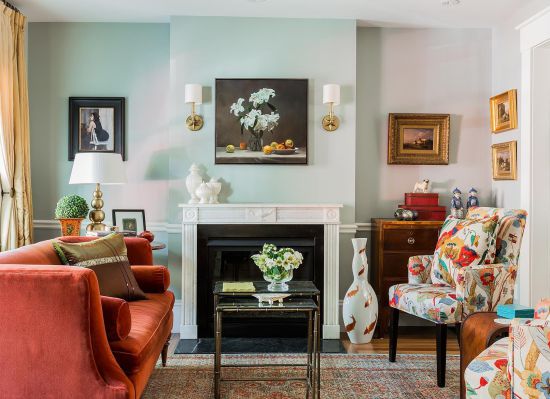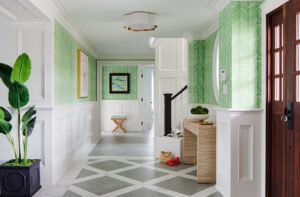Lawrence Powers: Learning About and Buying Art for the Home
September 25, 2015
Building an art collection evolves over time. It can start with a client’s decision to replace a college poster with original art. Or it is sometimes when a renovation or redesign of a room has taken place. The priority is usually to find art for locations in the house that are focal points, such as over the mantel or over a sofa in a main living area. Art is so subjective, it is important to develop one’s taste. We encourage clients to look at and consider all sorts of ideas for their homes. Taking art “on approval” is a regular practice for many galleries, as it is the best way for clients to get a feel for the artwork in the context of their own environment. We also take the same approach with interior designers and have them take artwork “on approval” to show their clients. It is usually the finishing touch to a project.
Introducing artwork into your home is always exiting and has great visual impact. There are a few guidelines that may be helpful in this process.

Photography by Michael J. Lee
Interior design by Kathy MacDonald Marshall
"Curves", oil/canvas, Alastair Dacey and "Lilies and Apples," oil/canvas, Marshall Henrichs
What do you like? Learning about art.
When building a collection, it should be about surrounding oneself with artwork that gives satisfaction and has staying power. It should reflect who you are and what is important to you. Taste in art is informed by so many things, from time spent in museums looking at iconic pictures to making a habit of visiting galleries and seeing what new artists are doing. The emotional connection that is made with a piece of art transforms the artwork into a personal expression of the collector and therefore, a reflection of their personality and experience. We encourage the collector to consider a variety of art within their collection. Having a good and trusting relationship with the gallery is another key point in collecting. It can be incredibly helpful to watch how a gallery/art consultant and designers curates their exhibits, to see what their vision is and how it fits within the context of one’s own collection. We find that once clients have started down the road of collecting, they get so much satisfaction from living with art that they just keep on going!

Photograph by Lawrence Powers
Mulitple pieces in a grid can be effective on a large wall.
Interior design by Victoria Stamm-Coffey
Map of Nevis Powers Gallery
Placement/Context
A work of art is most successful when it feels like it belongs in a particular setting or spot. Hanging art in a home can be an art in itself where pieces are placed for the best visual impact. Another aspect of hanging and choosing artwork for a given space is the desired feeling one wants for a given room or space. The main living space in a home should be a comfortable and beautiful space for everyone. The artwork plays a huge role in setting the tone for a room. For some collectors that means celebrating beauty and precious things. For others it can be a space devoted to conjuring up warm memories of happy places. Still others just want to focus on the colors and light in the space and continue that in the artwork. Once a collection is started, it is important to think about how the artworks will “speak” to each other and if they work well together.

Photograph by Lawrence Powers
A variety of styles can be very effective when placed thoughtfully
"September Light," oil/panel, Arnold Desmarais
"Water Views," oil/canvas, Laurence Young
Lighting
Proper lighting of a painting creates a wonderful focal point especially at night. Light will bring out all the colors and textures the artist has created to make the painting come alive. Lighting can be achieved in a few different ways. Recessed lighting that is aimed at the wall is most effective. When possible, picture lights are also very effective and can create a more intimate atmosphere around the painting. They are best when plugged into a clock receptacle behind the painting and connected to a wall switch.

Photograph by Lawrence Powers
Interior design by Mally Skok
"Marsh Colors VI," oil/panel, Margaret Gerding
Framing
The right frame is so important in the success of a painting. A frame that is properly selected enhances the artwork in that it looks like it belongs with the artwork, but it also has to work with the other elements of the space in which it is hanging. Depending on the medium of the artwork, the framing can preserve the most important qualities of the artwork, particularly when it is a work on paper, which can be much more vulnerable to the environment. The right frame, matting and glass can serve to keep the artwork in archival condition, for generations to enjoy.
Beautiful, elegant gold leaf frames have their place with somewhat more formal pieces of art. By definition, those kinds of frames convey a certain seriousness and quality.
Alternatively, more contemporary work is often framed in more minimal frames called “float fames” that serve to finish off the edges of the painting, but do not distract much at all from the artwork itself. The classic black frame is often a great answer, particularly when it comes to photographs. It all depends on so many different elements, most importantly the art itself, but also the style of the space where it will hang.

Photograph by Lawrence Powers
Artwork in a series or multiple pieces creates a nice rhythm on a large wall.
Interior design by Carol Friedman
"Pondscape Triptych," oil/canvas, Carol O'Malia
The Power of Art
Lately there has been an exciting buzz with a renewed interest in fine art for the home. There is a palpable feeling in the air with clients and designers discovering the power of original art and how it enlivens and enriches the home.
Lawrence Powers, is the owner of Powers Gallery in Acton, Massachusetts. The next exhibit, opening on November 7th, is “Building an Art Collection.” Larry wrote this post along with Evelyn Smith Scally, Art Consultant/ Frame Designer, and Elizabeth Hanson, Art Consultant
< previous post ¦ next post >
Share
![NEH-Logo_Black[1] NEH-Logo_Black[1]](https://www.nehomemag.com/wp-content/uploads/2022/08/NEH-Logo_Black1-300x162.jpg)







